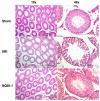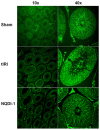The Thioredoxin System is Regulated by the ASK-1/JNK/p38/Survivin Pathway During Germ Cell Apoptosis
- PMID: 31547465
- PMCID: PMC6767173
- DOI: 10.3390/molecules24183333
The Thioredoxin System is Regulated by the ASK-1/JNK/p38/Survivin Pathway During Germ Cell Apoptosis
Abstract
The aim is to explore the mechanism of the apoptosis signal-regulating kinase-1 (ASK-1) signaling pathway and the involvement of the thioredoxin (Trx) system during testicular ischemia reperfusion injury (tIRI) by using ASK-1 specific inhibitor, NQDI-1. Male Sprague-Dawley rats (n = 36, 250-300 g) were equally divided into 3 groups: sham, tIRI, and tIRI + NQDI-1 (10 mg/kg, i.p, pre-reperfusion). For tIRI induction, the testicular cord and artery were occluded for 1 h followed by 4 h of reperfusion. Histological analyses, protein immunoexpression, biochemical assays, and real-time PCR were used to evaluate spermatogenesis, ASK-1/Trx axis expression, enzyme activities, and relative mRNA expression, respectively. During tIRI, ipsilateral testes underwent oxidative stress indicated by low levels of superoxide dismutase (SOD) and Glutathione (GSH), increased oxidative damage to lipids and DNA, and spermatogenic damage. This was associated with induced mRNA expression of pro-apoptosis genes, downregulation of antiapoptosis genes, increased caspase 3 activity and activation of the ASK-1/JNK/p38/survivin apoptosis pathway. In parallel, the expression of Trx, Trx reductase were significantly reduced, while the expression of Trx interacting protein (TXNIP) and the NADP+/ nicotinamide Adenine Dinucleotide phosphate (NADPH) ratio were increased. These modulations were attenuated by NQDI-1 treatment. In conclusion, the Trx system is regulated by the ASK-1/Trx/TXNIP axis to maintain cellular redox homeostasis and is linked to tIRI-induced germ cell apoptosis via the ASK-1/JNK/p38/survivin apoptosis pathway.
Keywords: ASK-1; JNK; NQDI-1; germ cell apoptosis; oxidative DNA damage; survivin; testicular ischemia reperfusion injury; thioredoxin.
Conflict of interest statement
The authors declare no conflict of interest. The funders had no role in the design of the study; in the collection, analyses, or interpretation of data; in the writing of the manuscript, or in the decision to publish the results.
Figures







References
-
- Sharp V.J., Kieran K., Arlen A.M. Testicular torsion: Diagnosis, evaluation, and management. Am. Fam. Physician. 2013;88:835–840. - PubMed
-
- Watanabe T., Sekine S., Naguro I., Sekine Y., Ichijo H. Apoptosis Signal-regulating Kinase 1 (ASK1)-p38 Pathway-dependent Cytoplasmic Translocation of the Orphan Nuclear Receptor NR4A2 Is Required for Oxidative Stress-induced Necrosis. J. Biol. Chem. 2015;290:10791–10803. doi: 10.1074/jbc.M114.623280. - DOI - PMC - PubMed
MeSH terms
Substances
Grants and funding
LinkOut - more resources
Full Text Sources
Research Materials
Miscellaneous

